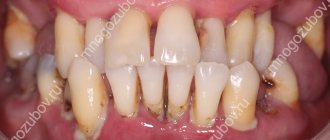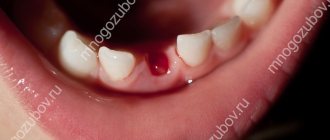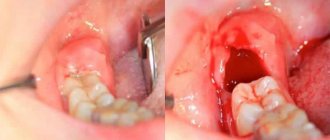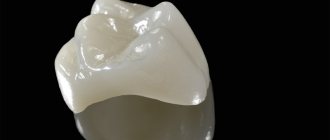2425
When a person loses teeth due to various factors, he faces many problems, ranging from deterioration in appearance to changes in the functioning of the entire body.
Modern methods of prosthetics will help solve the problem of missing teeth. The main thing is to understand which version of the prosthetic design is best suited in a given situation.
Within 2 weeks after removal
Dentists agree on how long it will take to start prosthetic teeth after extraction, in the absence of acute indications for performing the manipulation immediately after the operation.
The optimal time is 2 weeks after surgery. At this time, the socket is healing, it is covered with light crusts of newly formed epithelium, and new bone tissue appears. The period is well suited for the following manipulations:
- replacing temporary dentures with permanent structures;
- removable prosthetics.
At this time, the wounds that remain after tooth loss heal. Prosthetics are possible in the absence of inflammation. The dentures are made in advance.
Prices for prosthetics in China (Heihe)
| Complete removable acrylic denture 1 jaw, 5 year warranty | 11000 rub. |
| Microprosthesis (1-2 artificial teeth) | 2000 rub. |
| Microprosthesis (3-4 artificial teeth) | 3500 rub. |
| Partial removable acrylic denture with clasp fastening | 8000 rub. |
| Installation of ceramic teeth on an acrylic base, the cost is calculated based on the number of units of teeth, 1 unit, plus - the cost of the acrylic base, - the cost of the polyurethane base | 1200 rub. 2000 rub. 4000 rub. |
| Reinforcement of a removable denture with titanium mesh | 1000 rub. |
| Removable clasp dentures made of polyurethane with clasp fastening (plastic teeth made in Germany) 1 simple jaw | 14,000 rub. |
| Removable clasp dentures made of polyurethane with clasp fastening (plastic teeth made in Germany) 1 complex jaw with a multi-link clasp, with several clasps | 13000 rub. |
| Clasp prosthesis with locking fastening | from 36,000 rub. |
| Removable nylon elastic denture | 15,000 rub. |
| Prosthesis correction (superstructure) | 250 rub. |
Implantation after tooth amputation
After the tooth is extracted, a peculiarity appears - the absence of an abutment tooth or even a stump on which a crown could be placed. The root on which the prosthesis could rest in the future is also removed. That is why implantation is considered one of the most correct decisions.
The implantation itself is a minor surgical procedure that takes place in several stages.
At the first stage, the hole is prepared. The gentle removal process greatly simplifies and reduces preparation time.
Then a titanium (zirconium oxide) rod is installed into the jaw bone through the hole, on which the abutment and the selected crown will be attached in the future. A crown can be placed immediately, but only a temporary one (plastic), since the production of modern durable options (ceramics, metal-ceramics) and their fitting takes several weeks.
Classic dental implantation
Many people want to know when they can get dentures after tooth extraction using implantation. As a rule, the entire process from start to finish takes from 3 to 6 months, but an extracted tooth can be restored in a matter of days with the help of temporary crowns, which return functionality and aesthetics to the dentition.
As for the types of implants, the most common can be considered lamellar (suitable for older people or in the case of a specific structure of the area) and basal (designs that allow you to quickly restore a molar).
Indications for immediate prosthetics
Prosthetics is the replacement of lost units of the dentition with artificial crowns. Often, dental implants are also required in order not to lose chewing function and maintain correct bite. A permanent or removable crown can be attached to the top of the implant. As a rule, dentures are a necessary measure to restore the ability to eat normally, as well as to return a person to a beautiful smile.
- In cases where, for some reason, a significant part of the dental crown has been lost, a bridge can be installed. This structure is non-removable; it is attached to adjacent units of the dentition - abutment teeth. The void between the supporting units can be filled with artificial material, which is usually called a bridge or the body of the prosthesis.
A bridge can restore no more than two or three missing teeth. If you neglect this rule, the bridge can break quite quickly due to too high a chewing load.
- In cases where the patient has severe edentia or loss of most teeth, experts recommend installing implants. Despite their higher cost, with them you don’t have to worry about bone tissue atrophy and the durability of the structure.
- A problem such as the absence of a tooth in the frontal area of the jaw is unlikely to make someone attractive. That is why, when removing a tooth in front, patients most often think about immediate prosthetics.
When can you get removable dentures?
Are you planning to remove one or more teeth and immediately install a removable denture? Again, it will not be possible to do this at the same time, because the soft tissues after surgery will be injured and will need time to heal. And the prosthesis will put pressure on the irritated mucous membrane, which is completely undesirable during the rehabilitation period. On average, healing will take two weeks.
After this period, you can return to prosthetics. But at first, you should choose only very light structures - for example, from nylon or acrylic. They are made of soft material that will not harm inflamed mucous membranes. This design perfectly masks external smile defects and restores its aesthetics.
We suggest you familiarize yourself with how long after tooth extraction you can get dentures: when to install removable dentures, how many days the gums heal, treatment
But as for the feeding process, here the patient will have to face significant restrictions: the device cannot be subjected to a strong chewing load, and only soft food will need to be eaten. Moreover, for quite a long time - until the tissues are completely rehabilitated after tooth extraction.
This takes from a month to six months maximum - it all depends on the individual characteristics of your body.
Afterwards, you can think about a more durable and comfortable prosthetic option.
Indications and contraindications
The main indications for prosthetics include partial or complete loss of incisors associated with severe caries or chipping of part of the tooth.
If there are temporary causes, the doctor first eliminates them, no matter how much time it takes, and then only has the right to begin the procedure for installing the prosthesis.
During pregnancy, implantation can only be performed if such permission has been given by a gynecologist.
In rare cases, installing temporary teeth is not recommended at all. There are not many reasons for this, but they exist.
If the patient had infections in the oral cavity for some time before prosthetics, then you should wait some time until all tissues are completely healed.
When the doctor is not sure that the implant will take root, you will also have to wait for a while. As soon as the reasons for doubt disappear, the issue of prosthetics can be returned to again.
There is little that can interfere with the installation of the immediate. However, if inflammation of the soft tissues is detected, it is worth abstaining from even this option for a while.
Features of prosthetics after removal
As for the prosthetics itself, it should be carried out only in the absence of infection of the socket, inflammatory processes, active diseases of the oral cavity, or poor hygiene. The gums should not bleed, nor should the socket itself.
Many people are interested in how many days after removal they can place an implant in the socket. Unfortunately, it is difficult to give exact dates, because each case is individual, and much depends on hygiene, healing speed, the presence of illnesses or weakened immunity.
In addition, the timing varies depending on the type of prosthesis chosen by the patient, the type of structure and fastening system, and the materials used. The production of plastic implants, for example, takes much less time than the production of metal-ceramic crowns.
Metal-ceramic crowns
Of course, in case of removal, it is better to prefer implantation to prosthetics. Firstly, the hole for the rod and crown is already ready and does not require additional manipulation, which makes the whole process easier for the patient.
Secondly, the implant provides a healthy load and pressure on the socket and jawbone, which improves blood supply to the area, and, therefore, its nutrition with useful components.
Thirdly, the finished socket allows you to perform the so-called “one-step” or express implantation, which saves the patient time and money, and makes it possible to enjoy aesthetic dentition in a matter of days.
In any case, dentists advise that all manipulations (extraction, socket preparation, prosthetics or implantation) be performed not only in one clinic, but also with one specialist. He will follow all the rules of gentle amputation, which allows the hole to be used for the installation of artificial structures. That is, the doctor prepares the hole at the removal stage for the prosthesis chosen by the client.
An example of a one-stage implantation operation with immediate loading
Let's consider a specific example - a fracture of a front tooth at the root. In such cases, the most reliable, durable and predictable form of prosthetics is the implantation of a missing tooth. The picture shows that the tooth was previously treated endodontically.
The following treatment plan was proposed: tooth extraction followed by immediate implantation and installation of a temporary crown, installation of a permanent crown after the implant has healed. The patient approved of this plan. Let's look at the operation step by step.
Before the operation, the patient passed all the necessary tests, the oral cavity was sanitized and prepared for surgery.
In the photo, the root of the tooth has just been removed. Simultaneous implantation and installation of a temporary crown are planned.
It is very important to remove the root of the tooth as carefully as possible. Alveolar bone should be preserved as much as possible. For better implant healing, a platelet-rich clot was used.
Installation and adjustment of the plastic abutment. A plastic abutment with such a purpose that it should break before the load is transferred to the bone (in case of an emergency).
In the following photos, a temporary crown blank is installed on the implant. It will be polished, removed from the bite and temporarily glued to the adjacent teeth. This is done in order to reduce the load on the implant on which it is installed until it heals. The crown is also shown after completion of its aesthetic design.
DETAILS: Alternative to Dental Implants
Approximately one hour after tooth root removal, the patient resolves the aesthetic issue and does not experience discomfort during communication. He calmly waits until the implant takes root and it becomes possible to install a permanent crown.
Approximately 40 minutes passed from the moment the tooth was removed until the last photo was taken.
Prosthetics or restoration
The tooth is restored immediately after its removal due to destruction, chipping, natural wear, acute forms of caries and other diseases of the oral cavity. That is why the amputation procedure is performed in most cases of implantation and prosthetics. In rare cases, elements of a row are restored using restorations, inlays, veneers, filling composite, etc.
However, the natural shape, color and functionality of a tooth can only be restored by installing crowns.
What are the differences between prosthetics and partial restoration and restoration will be discussed below.
- Teeth look uniform and whole only after prosthetics, and in the case of restoration, you can notice the place where the composite was added, since over time it can change color or even fly off.
After restoration, the added component may change light over time or even fly off - The duration of implantation ranges from 3-4 stages, while the restoration is done promptly while preserving the tooth.
- The patient visits several doctors to obtain permission to perform a mini-surgery in the oral cavity.
- Restoring a damaged tooth is cheaper, however, prosthetics allows you to restore a long-removed molar.
- After implantation, the crown will last much longer than the restored tooth.
- Unfortunately, prosthetics has a number of contraindications and side effects.
We suggest you read What to do if you are afraid to go to the dentist
After the above, it seems that it is much easier to restore a tooth than to remove it and replace it with another. But dentists have different views. The service life of various inlays, fillings and veneers does not exceed 5-7 years, after which they should be replaced. To do this, the tooth enamel is again subjected to grinding and sharpening until a weakened stump remains.
Sooner or later, the damaged tooth will still have to be removed and a prosthesis installed, but during this period you will spend a lot of money and time on going to the doctor to correct the enamel surface.
When can all teeth be replaced with implants?
With complete edentia, patients today have the unique opportunity to receive a full-fledged fixed prosthesis immediately after the removal of decayed teeth: the roots are extracted, implants are simultaneously placed in their place, after which new teeth are fixed. All this in 1-3 days. We are talking about revolutionary implantation protocols with immediate loading. The patient immediately returns to his normal lifestyle, can eat and smile beautifully.
If a tooth needs to be removed, do not put off the decision to restore it for too long. Act immediately - this will help you save money, maintain your health and beauty, and also immediately restore your chewing function.
Types of temporary dentures with photos
Temporary standard dentures, photos of which are very easy to find on the Internet, come in different types. Temporary standard dentures for the upper jaw and lower jaw do not differ much from each other in terms of installation methods.
Types of temporary structures:
- dentures that can be removed;
- dentures that cannot be removed.
Temporary standard butterfly dentures are often offered to be installed in dentistry. They place it on one or several teeth. This type of temporary prosthesis is made from artificial materials and connected using a soft “petal” type attachment to other teeth. It is almost impossible to distinguish it from a natural human tooth and it looks very organic in the photo.
Dentures that cannot be removed are usually chosen by young people. The most common are crowns and simple bridge-type products. They are attached to the front teeth. It is not possible to remove such a structure on your own - there is a risk of damage to the front teeth. With their help, the oral cavity gradually adapts to the presence of a foreign body in the body. Temporary difficulties that arise when cleaning your mouth can be eliminated with the help of special brushes and cleaning products.
Who needs a prosthesis?
Partial dentures are needed for people who still have some of their natural teeth. Dentures are not just for older patients. Patients of any age may lose some or all of their teeth and may require some type of denture. Because teeth are a permanent part of the body, tooth loss can have an emotional impact on some people. It is important to talk to your dentist about any fears, worries, or other emotions you feel about losing a tooth.
Rules for using dentures and caring for them
To prevent complications, as well as to fully use dentures, it is necessary to follow certain rules and carefully care for them. Caring for dentures depends on their design. Fixed dentures are cared for in the same way as natural teeth. But plastic inlays, crowns, post teeth, bridges with plastic lining are less common than teeth. Therefore, such dentures must be used very carefully - do not chew crackers, do not eat sticky sweets such as toffee, as they stick to the surface of the dentures and can lead to disruption of their stability. With dentures, especially, the hygienic condition of the oral cavity worsens, creating favorable conditions for the life of microbes. The hygienic condition of the oral cavity deteriorates especially sharply in people who abuse sugar, alcohol, and smoke. A lot of stones and soft plaque are deposited on their teeth. Smokers develop a brown coating due to the build-up of nicotine. In addition, if you abuse alcoholic beverages, blood circulation in the tissues surrounding the tooth is disrupted, which leads to early tooth loss.
To prevent complications caused by the influence of microorganisms and their poisons, it is necessary to especially carefully monitor the hygienic condition of the oral cavity, remaining teeth and dentures. To eliminate food residues after eating, you need to rinse your mouth with warm water, weak solutions of potassium permanganate, sodium bicarbonate (baking soda), sodium chloride (kitchen salt) and decoctions of sage, St. John's wort, and chamomile. Fixed dentures, like natural teeth, are cleaned with tooth powder or paste. You need to use a soft toothbrush made of natural bristles and change it after 6-8 months. The movement of the brush when brushing teeth and fixed dentures should be mainly in the vertical direction: when brushing the teeth of the upper jaw from top to bottom, and when brushing the teeth of the lower jaw - from bottom to top.
You should also make several horizontal movements along the outer, inner and chewing surfaces of teeth and dentures to completely remove plaque and food debris. After brushing your teeth, your mouth should be rinsed thoroughly with warm water or a disinfectant solution. Food can become trapped in the gaps between the alveolar ridge and the pontic pontic. It cannot be removed using sharp objects, as this can injure the mucous membrane and cause inflammation. It is best to thoroughly clean dentures with a toothbrush and rinse your mouth after eating.
Removable dentures are somewhat more difficult to care for. When receiving a removable denture (especially a partial one), the first thing you need to do is learn how to use it. If inserted and removed incorrectly, the denture can break and injure the oral mucosa. Sometimes, due to the pressure of a sharp or long edge, the presence of roughness, sharp protrusions on the surface of the prosthesis adjacent to the mucous membrane, pain occurs. The cause of pain is not always easy to identify and eliminate. In this case, you need to consult a doctor.











